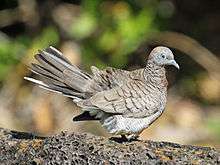Zebra dove
| Zebra dove | |
|---|---|
 | |
| A zebra dove in Phetchaburi, Thailand | |
 | |
| A feral zebra dove at Kauai, Hawaii where it is an introduced species | |
| Scientific classification | |
| Kingdom: | Animalia |
| Phylum: | Chordata |
| Class: | Aves |
| Order: | Columbiformes |
| Family: | Columbidae |
| Genus: | Geopelia |
| Species: | G. striata |
| Binomial name | |
| Geopelia striata (Linnaeus, 1766) | |
The zebra dove (Geopelia striata) also known as barred ground dove, is a bird of the dove family, Columbidae, native to Southeast Asia. They are small birds with a long tail. They are predominantly brownish-grey in colour with black-and-white barring. They are known for their pleasant soft, staccato cooing calls.
Taxonomy
The zebra dove is closely related to the peaceful dove of Australia and New Guinea and the barred dove of eastern Indonesia. These two were classified as subspecies of the zebra dove until recently and the names peaceful dove and barred dove were often applied to the whole species.
Habitat and range
The native range of the species extends from Southern Thailand, Tenasserim, Peninsular Malaysia, and Singapore to the Indonesian islands of Sumatra and Java. It may also be native to Borneo, Bali, Lombok, Sumbawa, and the Philippine islands.
The zebra dove is popular in captivity and many populations have appeared outside its native range due to birds escaping or being deliberately released. It can now be found in central Thailand, Laos, Borneo, Sulawesi, Hawaii (introduced in 1922), Tahiti (1950), New Caledonia, the Seychelles, the Chagos Archipelago (1960), Mauritius (before 1768), Réunion, and Saint Helena.
It inhabits scrub, farmland, and open country in lowland areas and is commonly seen in parks and gardens. Trapping for the cagebird industry has led to them becoming rare in parts of Indonesia but in most parts of its range it is common. Zebra doves are among the most abundant birds in some places such as Hawaii and the Seychelles.
Description
_-_Philippines.jpg)
The birds are small and slender with a long, narrow tail. The upperparts are brownish-grey with black-and-white barring. The underparts are pinkish with black bars on the sides of the neck, breast and belly. The face is blue-grey with bare blue skin around the eyes. There are white tips to the tail feathers. Juveniles are duller and paler than the adults. Zebra doves are 20-23 centimetres in length with a wingspan of 24–26 cm.
Their call is a series of soft, staccato cooing notes. In Thailand and Indonesia, the birds are popular as pets because of their calls and cooing competitions are held to find the bird with the best voice. In Indonesia this bird is called perkutut. In the Philippines they are known as batobatong katigbe ("pebbled katigbe") and kurokutok; in Malaysia this bird is called merbok, onomatopoeic to their calls.[2] They are also known as tukmo in Filipino, a name also given to the spotted dove (Spilopelia chinensis) and other wild doves.
Feeding
The zebra dove feeds on small grass and weed seeds. They will also eat insects and other small invertebrates. They prefer to forage on bare ground, short grass or on roads, scurrying about with rodent-like movement. Unlike other doves, they forage alone, or in pairs. Their colouration camouflages them wonderfully against the ground.
Reproduction
In its native range the breeding season is from September to June. The males perform a courtship display where they bow and coo while raising and spreading the tail. The nest is a simple platform of leaves and grass blades. It is built in a bush or tree or sometimes on the ground. One or two white eggs are laid and are incubated by both parents for 13 to 18 days. The young leave the nest within two weeks and can fly well after three weeks.[2]
References
- ↑ BirdLife International (2012). "Geopelia striata". IUCN Red List of Threatened Species. Version 2013.2. International Union for Conservation of Nature. Retrieved 26 November 2013.
- 1 2 Robert Kennedy (2000). A Guide to the Birds of the Philippines. Oxford University Press. pp. 149–150. ISBN 9780198546689.
- Pratt, H. Douglas; Philip L. Bruner; & Delwyn Berrett (1987). A Field Guide to the Birds of Hawaii and the Tropical Pacific. Princeton University Press.
- Robson, Craig (2002). A Field Guide to the Birds of South-East Asia. New Holland Publishers (UK) Ltd.
- Skerrett, Adrian; Ian Bullock; & Tony Disley (2001). Birds of Seychelles. Christopher Helm.
| Wikimedia Commons has media related to Geopelia striata. |
